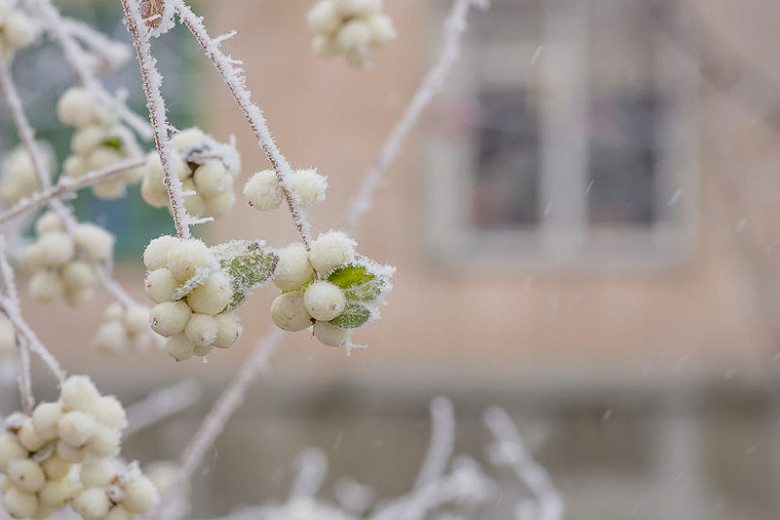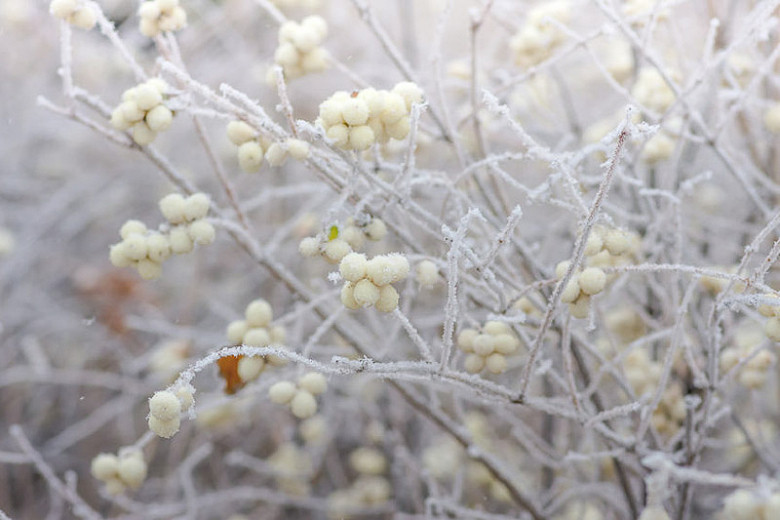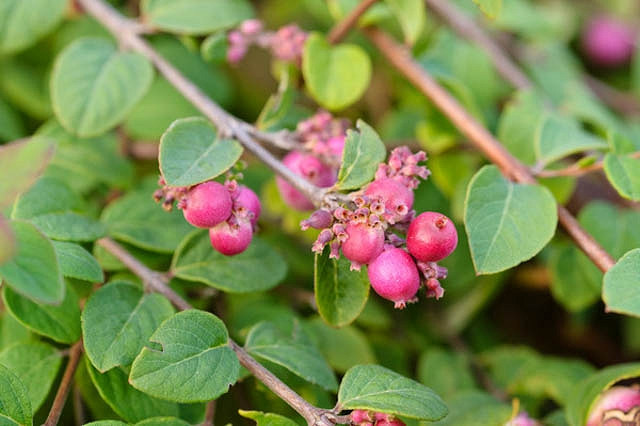Symphoricarpos albus (Common Snowberry)
Noted for its very ornamental, pure white, waxy berries, Symphoricarpos albus (Snowberry) is a thicket-forming, deciduous shrub with upright to arching branches that is amazingly adaptable and undemanding.
Noted for its very ornamental, pure white, waxy berries, Symphoricarpos albus (Snowberry) is a thicket-forming, deciduous shrub with upright to arching branches that is amazingly adaptable and undemanding. In early summer, a profusion of small, bell-shaped, white to pink flowers are borne in clusters in the leaf axils. Inconspicuous, they are of great interest to butterflies, hummingbirds and pollinators. The flowers are followed by abundant and attractive clusters of brilliant snow-white berries that persist well into winter. Birds, game birds and small mammals do enjoy them in winter months. The dense foliage of elliptic to rounded, blue-green leaves, remains attractive from spring to frost but provides little fall color.
- Grows up to 3-6 ft. tall and wide (90-180 cm) with a bushy, rounded habit. This plant spreads by underground suckers
- A full sun to part shade lover, this plant is easily grown in average, medium moisture, well-drained soils. Tolerates full shade and a wide range of soils, including poor soils, dry soils, clay soils but excluding wet soils. Best fruit production occurs in full sun. Drought and pollution tolerant
- Low maintenance, Snowberry is generally pest and disease free, but watch for occasional anthracnose, powdery mildew, leaf spot, rust and berry rot.
- Attracts birds, but is deer resistant.
- Excellent in mixed shrub borders, screens or hedges, slopes and erosion control, open woodland areas or as a groundcover.
- Prune as required in late winter to early spring
- Propagate by cuttings or by seeds
- Fruit can cause mild stomach upset if ingested.
- Native from Nova Scotia to British Columbia south to Oregon, New Mexico, Illinois and Virginia.
Requirements
| Hardiness | 3 – 7 |
|---|---|
| Heat Zones | 1 – 7 |
| Climate Zones | 1A, 1B, 2A, 2B, 3A, 3B, 4, 5, 6, 7, 8, 9, 10, 11, 14, 15, 16, 17, 18, 19, 20, 21, A3 |
| Plant Type | Shrubs |
| Plant Family | Symphoricarpos – Snowberries |
| Exposure | Full Sun, Partial Sun, Shade |
| Season of Interest | Summer (Early,Late)FallWinter |
| Height | 3' – 6' (90cm – 180cm) |
| Spread | 3' – 6' (90cm – 180cm) |
| Spacing | 36″ – 72″ (90cm – 180cm) |
| Water Needs | Average |
| Maintenance | Low |
| Soil Type | Chalk, Clay, Loam, Sand |
| Soil pH | Acid, Alkaline, Neutral |
| Soil Drainage | Moist but Well-Drained, Well-Drained |
| Characteristics | Showy |
| Native Plants | United States, Alaska, California, Midwest, Illinois, Indiana, Iowa, Michigan, Minnesota, Missouri, Nebraska, North Dakota, Ohio, South Dakota, Wisconsin, Northeast, Connecticut, Delaware, Maine, Massachusetts, Maryland, New Jersey, New York, Pennsylvania, Rhode Island, Vermont, Pacific Northwest, Idaho, Oregon, Washington, Rocky Mountains, Colorado, Montana, Utah, Wyoming, Southeast, Kentucky, North Carolina, Tennessee, Virginia, West Virginia, Southwest, New Mexico |
| Tolerance | Clay Soil, Deer, Drought, Dry Soil |
| Attracts | Birds, Butterflies, Hummingbirds |
| Garden Uses | Banks and Slopes, Ground Covers, Hedges and Screens |
| Garden Styles | Informal and Cottage, Prairie and Meadow, Traditional Garden |





